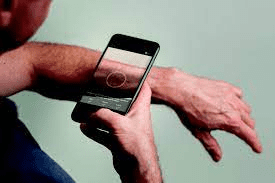In recent years, smartphone penetration in the United States has continued to grow. At the same time, deep learning has helped to significantly lower the error rate of image recognition tools. The two of these in combination have helped to open up new possibilities for us to use smartphones as diagnostic tools.
One company called SkinVision uses smartphone cameras to assess skin cancer risk and to monitor skin lesions. A number of platforms are offering machine learning as a service and integrating with FDA-approved home monitoring devices so that they can alert physicians when they spot an abnormality. Biofourmis is using an AI analytics engine that pulls data from FDA-cleared medical wearables and predicts health outcomes for patients. Then there’s ContinUse Biometrics, an Israeli company that’s developing its own sensing technology using AI to process over twenty bio-parameters—such as glucose levels, blood pressure and heart rate—and spot abnormalities. As well as generating a rich source of daily data, AI-IoT has the potential to reduce time and costs associated with preventable hospital visits.
Gauss surgical, an AI diagnostic company, partnered with biotech company Cellex to develop at-home COVID-19 rapid diagnostic kits. To conduct its antigen test, consumers are guided to apply a nasal swab using one of Cellex’s at-home test kits. Gauss’ AI app then prompts users to scan the test with their smartphones, and then neural networks process the image and display a result within seconds.
Wearables already used in hospital settings are showing success when used outside of clinical settings to monitor patients and facilitate better outcomes. Current Health’s device is an upper-arm wearable that taps into AI to track and analyze patients’ vital signs at home, tracking temperature, pulse, respiration, oxygen saturation and movement. This allows it to offer round-the-clock “ICU-level accuracy and to provide actionable insights so that clinicians can monitor their patients’ health and intervene if it spots a problem. It also has a 90% adherence rate in home settings, which is double the national standard, and it’s been proven to reduce readmissions and ED visits. The company’s proprietary algorithms continuously analyze data to derive a patient’s health trajectory by detecting potential indicators of patient decline earlier for faster intervention






